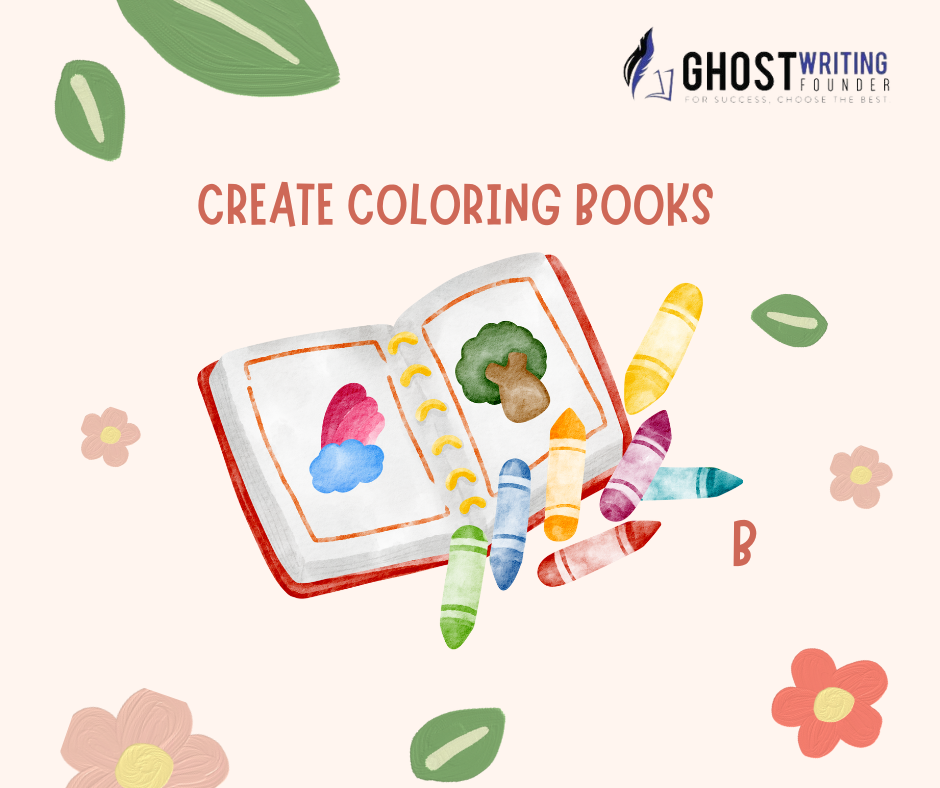
Book
In the past few years, coloring book creations have become more than just something kids use. Now, adults also enjoy them as a way to relax. People want coloring books that are special and match their tastes. This means Professional book writing authors must ensure their coloring creations are exactly what their audience likes. Join us on an imaginative adventure to discover what makes a coloring book interesting and fun.
Understanding Your Target Audience
Before you start coloring, knowing who you’re making it for is really important. Are you making it for kids, grown-ups, or a specific group of people who like certain things? Doing some research will help you figure out the age group, likes, and what people expect when they color.
Imagine you’re about to create a beautiful picture with colors. But you want to make sure it’s something people will like. So, you first need to know who you’re making it for. Are you making it for kids, adults, or people who like certain things?
For kids, you might want to use bright colors and draw fun things like animals or cool characters. It’s important to know what kids like at their age. Do they like animals, fantasy worlds, or characters from cartoons? Knowing this helps you choose the right colors and designs.
If it’s for adults, it’s a bit different. Adults usually like more detailed and fancy designs. They might prefer a more sophisticated set of colors and themes that match their interests. This is where doing some research is super helpful. You can look at what other people are doing and figure out what adults like to color.
And if you’re making it for a specific group of people with unique interests, you need to dig even deeper. What are their hobbies or things they love? Tailoring your coloring creations to match their preferences will make the experience even more special for them. To do all this, you need to do some research. Look at what’s popular and what other people are doing, and ask questions to determine what your potential colorists like. You can do surveys, talk to people, or even check what’s happening on social media.
Design and Layout Considerations
Creating a visually appealing coloring book goes beyond choosing themes; the design and layout are also crucial. Spend time picking illustrations that look good and are interesting. Consider how the pages are arranged and the space between them for a better coloring experience.
Aesthetic Appeal:
Choose illustrations that not only fit your theme but are also visually attractive. The images should appeal to the eye, encouraging people to color them.
Engaging Illustrations:
Select images that capture attention and spark interest. The illustrations should be engaging and enjoyable to color, whether it’s cute characters, intricate patterns, or beautiful scenes.
Thoughtful Layout:
Pay attention to how the pages are organized. Consider the flow from one page to the next and how the illustrations are spaced. A well-thought-out layout enhances the overall experience for the person coloring.
Page Flow:
Ensure that there is a logical sequence or flow to the pages. This helps create a cohesive and enjoyable journey as users progress through the coloring book creations.
Spacing:
Suitable spacing between illustrations and on the page is essential. It gives room for coloring without feeling cramped and allows users to focus on one image at a time.
Coloring Book Paper and Printing Quality
The paper and printing in your coloring book creations can affect how much fun you have while coloring. Choosing paper that works well with different coloring tools is important, and it doesn’t let colors go through to the other side too much. The colors will look bright when the printing quality is good, making your finished artwork look nice and lively.
Incorporating Educational Elements
Elevate your coloring book creations from a pastime to an educational tool by seamlessly integrating learning elements. Whether it’s introducing fun facts, puzzles, or activities related to the theme, you’ll not only entertain but also contribute to the cognitive development of your audience.
Engaging Cover Design
The cover of a coloring book is a crucial element that goes beyond the adage “Don’t judge a book by its cover.” Cover design and typesetting serves as a powerful tool to captivate the audience. A well-designed cover reflects the core theme and content of the coloring book and acts as a visual invitation for potential colorists to delve into its pages.
The interesting cover of the coloring book sets the mood for the creative journey inside, making people curious and excited. It’s like a sneak peek that shows a bit of the creative world inside, motivating people to grab the book and start a colorful adventure.
Promoting Creativity and Personalization
Create a personal link between the person’s coloring and the artwork by leaving some empty spaces within the designs. These blank areas allow for personal touches, inspiring colorists to add their unique style to the pages.
Accessibility and Inclusivity
Ensure that your coloring book is accessible to a diverse audience. Embrace inclusivity by featuring various characters and themes that resonate with people from different backgrounds, ensuring everyone feels represented and welcomed.
Digital Options and Trends
Consider expanding your reach by exploring digital coloring book options in the digital age. Embrace technological trends, whether it’s through interactive features, virtual coloring experiences, or collaborations with digital platforms.
Collaborations and Licensing
Inject a dose of uniqueness into your coloring book by collaborating with talented artists or partnering with recognizable brands. However, tread carefully by understanding the copyright basics and ensuring all legal considerations are addressed.
Marketing Strategies for Coloring Books
Once your masterpiece is ready, it’s time to share it with the world. Leverage the power of social media platforms to showcase sneak peeks behind-the-scenes content and engage with your audience. Craft compelling marketing materials that highlight the distinctive features of your coloring book.
Gathering and Incorporating Feedback
Launch your coloring book with an open mind and be prepared to receive feedback. Take care of feedback and recommendations from your audience and professional services such as Ghostwriting Founder. Consider these insights as valuable input for enhancing your future projects and creations.
Tips for Self-Publishing
If you’re considering self-publishing, explore various platforms and distribution channels. Understand the logistics of printing, shipping, and sales, ensuring a smooth and successful journey from creation to the hands of your eager colorists. Follow the best self-publishing tips to get better results.
FAQS
How Much Are Children’s Book Writing Services for Children’s Book Creations?
The cost of children’s book writing services varies based on factors such as the book’s length, the complexity of illustrations, and the writer’s experience. It’s advisable to request quotes from different service providers and discuss your specific requirements.
What Are the Amazon Book Publishing Costs?
Amazon book publishing cost includes Kindle Direct Publishing (KDP) for ebooks and Print-on-Demand (POD) services. Costs can vary, but generally, there are no upfront fees for KDP, and POD costs are deducted from book sales. Reviewing Amazon’s pricing details and considering factors like printing and distribution costs is essential.
What Is the Popular Genre of Children’s Book Publishing?
The popularity of genres in children’s book publishing can vary, but timeless classics like picture books, middle-grade fiction, and young adult novels continue to be widely appreciated. Trends may shift, so staying informed about current preferences can help authors align their work with popular genres.
Key Characteristics and Profound Details
| Unique Coloring Book Elements | Description | Importance |
|---|---|---|
| Understanding Your Target Audience | Before creating, research your audience – kids, adults, or specific interests. Consider preferences, likes, and age groups. | Helps tailor coloring creations to audience preferences, enhancing the overall experience. |
| Design And Layout Considerations | Choose visually appealing illustrations, engage with captivating images, and ensure a thoughtful layout and page flow. | Elevates the visual and user experience, making the coloring book enjoyable and cohesive. |
| Coloring Book Paper And Printing Quality | Select suitable paper, considering compatibility with coloring tools, and ensure high-quality printing for vibrant colors. | Enhances the tactile and visual experience of coloring, making the finished artwork look vibrant. |
| Incorporating Educational Elements | Seamlessly integrate learning elements like fun facts or puzzles, transforming the coloring book into an educational tool. | Adds value to the coloring experience by contributing to cognitive development. |
| Engaging Cover Design | Design an enticing cover that reflects the theme, serving as a visual invitation for potential colorists. | Sets the mood for the creative journey inside, attracting and motivating people to explore the book. |
| Promoting Creativity And Personalization | Leave empty spaces within designs for personal touches, inspiring colorists to add their unique style. | Creates a personal connection between colorists and artwork, fostering creativity. |
| Accessibility And Inclusivity | Feature diverse characters and themes to ensure the coloring book is accessible and inclusive to a wide audience. | Creates a sense of representation and welcomes people from different backgrounds. |
| Digital Options And Trends | Explore digital coloring book options, embracing technological trends and collaborations with digital platforms. | Expands reach in the digital age, offering interactive and virtual coloring experiences. |
| Collaborations And Licensing | Collaborate with artists or partner with brands, understanding copyright basics for uniqueness. | Injects uniqueness into the coloring book, potentially reaching new audiences. |
| Marketing Strategies For Coloring Books | Leverage social media, showcase sneak peeks, and craft compelling materials to highlight unique features. | Helps create awareness and engages potential colorists, driving interest in the coloring book. |
| Gathering And Incorporating Feedback | Launch with an open mind, gather feedback, and consider insights for enhancing future projects. | Valuable input for continuous improvement, ensuring the coloring book meets audience expectations. |
| Tips For Self-Publishing | Explore platforms, understand logistics, and follow self-publishing tips for successful distribution. | Provides guidance for a smooth journey from creation to the hands of colorists. |
Conclusion
Creating coloring books that resonate with your target audience combines art, psychology, and market understanding. As you start this creative journey, remember that the true magic lies in the connection your coloring book establishes with its colorists. Craft each page carefully, foster creativity, and watch as your creation becomes a canvas for imagination.









Leave a Reply